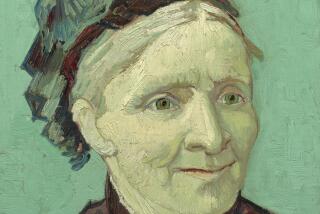ARTQUEST CONTEST WINNERS : ACCLAIM FOR 2 SDSU ART INSTRUCTORS
- Share via
SAN DIEGO — Robert Smith’s and Marian Galczenski’s multi-paneled paintings are worlds apart. Galczenski’s cool colored geometric forms contrast with Smith’s warm organic images. The media differ, as does the message.
However, both San Diego State University art lecturers were first-place winners in the oil-acrylic category of ArtQuest, a nationwide contest.
The annual juried competition was founded by Jonette Slabey last year to promote unacclaimed artists. For the last two years, about one-third of the 4,000 people who submitted slides of their work were painters.
The competition had 12 categories ranging from ceramics to wall reliefs. According to Slabey, some of the most important directors and curators in the United States are chosen to judge the contest. The top 36 award-winners in all media receive cash prizes and have their work exhibited in New York and Los Angeles.
“I think the jurors must have been excited by our format,” said Galczenski, winner of ArtQuest ’85. “We didn’t use the traditional flat, rectangular canvas. But I think it’s an incredible coincidence that two SDSU art instructors won two years in a row.”
Galczenski’s acrylic painting, “Program,” is made up of 45 units. In each panel the artist has painted a symbol used in computer programming.
Smith explained the mystery and meaning of his walk-in, three-sided painting, “Inconsolable Science”:
“I use images of black magic, scientific diagrams, religious paintings and scenes of everyday life,” he said. “I combine these disparate images to form a pictorial novel. As opposed to a traditional novel, here there is no linear narrative, but the images are set into a crisscrossing network of meanings built into an actual space.”
Smith’s painting uses a variety of materials, including velvet, vinyl, metal and fluorescent paint. He said he likes to use a medium that will manipulate his technique to create the best results. In the case of the black velvet, Smith uses the rich canvas as a revolt against the snobbery of the art world.
“Black velvet has always been associated with the cheesy paintings sold in Tijuana,” Smith said. “However, I have found that it’s quite a hard medium to work with. I have a lot of respect for those guys.”
Although Smith has been inspired by border culture and has drenched his work with his Arizona heritage, his velvet paintings are a far cry from gaudily painted matadors.
“Science” is like a complicated jigsaw puzzle in which the viewer must put the pieces together in order to get the story. Smith’s symbols contradict one another, making the meaning of the piece abstract.
“Realism is usually seen photographically, but along with this are layers of concept and meaning,” he said. “Underneath the banal surface existence, the purely visual, is a raging undercurrent of dream, spirit and culture. Therefore, to portray realism in its truest form, one must also represent the unseen.”
Smith was a finalist in last year’s ArtQuest, so he wasn’t surprised when he won this year’s competition.
“The nicest thing about winning is having my piece shown in New York,” Smith said. “It’s very flattering to be picked by a group as first class as this year’s jurors.”
And Galczenski said: “It certainly says a lot for San Diego State University’s art faculty.”
More to Read
The biggest entertainment stories
Get our big stories about Hollywood, film, television, music, arts, culture and more right in your inbox as soon as they publish.
You may occasionally receive promotional content from the Los Angeles Times.










